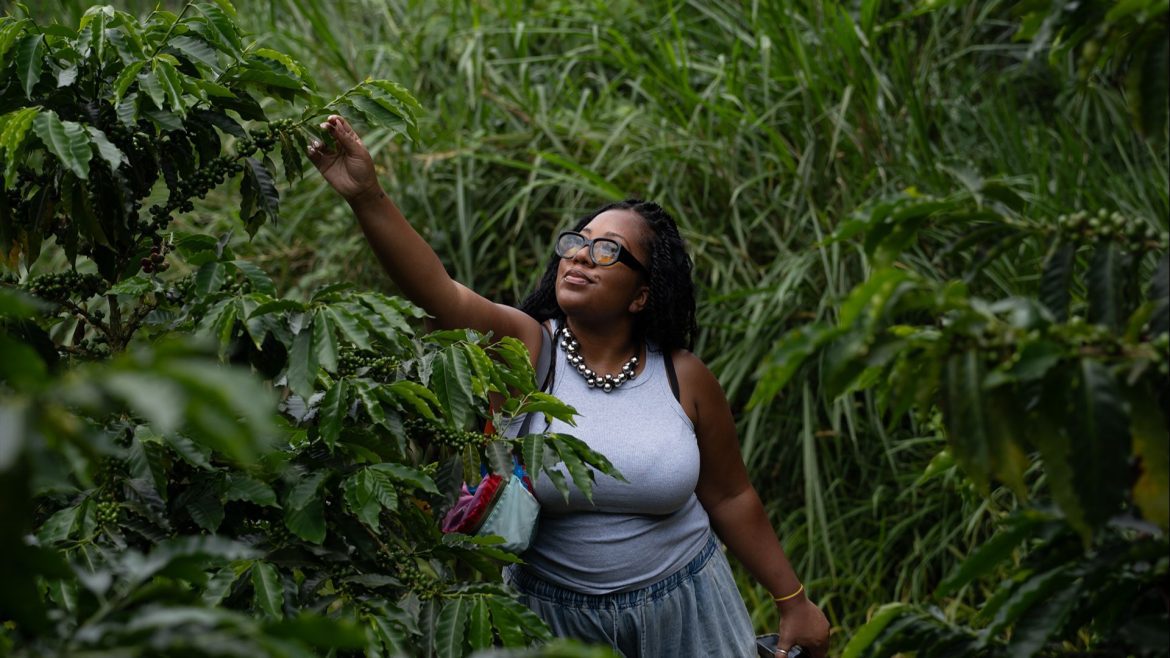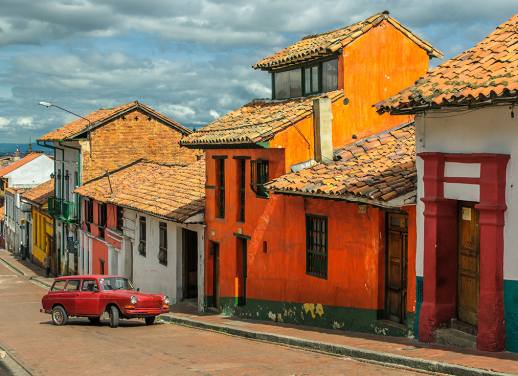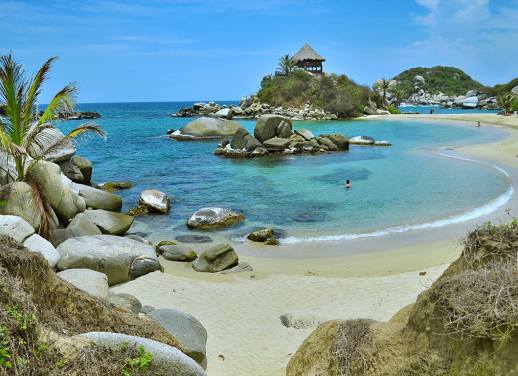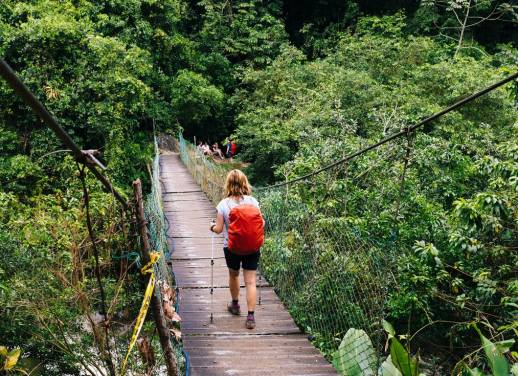Writer Glynn Pogue first visited South America as a backpacker, thinking she’d never return. But an Intrepid group trip changed her perspective.
The last time I was in Colombia I was a broke recent graduate backpacking along the Caribbean coast with my best friend. We hitched rides and took buses, sleeping in hostels and hammocks, until we arrived in La Guajira – an otherworldly place that forms a natural full stop at the very end of the country where the desert meets the sea.
After ten days of lush rainforests, lively beach towns and desert, in my mind I’d ‘done’ Colombia. Next, I wanted new passport stamps, new experiences… After all, what more could one country give me?
A lot, it turns out.



Treading new ground in Colombia
I return nearly seven years later as a whole new woman, lured back as a mentor on Intrepid’s annual BIPOC mentorship trip – which encourages diverse voices in travel writing.
This time, I’m not just travelling: I’m sharing what I’ve learned about the road and storytelling, and seeing how much more sure of myself I’ve become; finally gainfully employed, a little more settled, a little less directionless – but maybe also a little less idealistic than I was back then, when what lay ahead felt so unknown.
This time around my journey begins in Salento – a sleepy, storybook town ensconced in the Cocora Valley, west of Bogota, that’s home to the tallest palm trees in the world.
Ready to experience the Best of Colombia adventure, my group and I arrive at our colourful guesthouse just after sunset. At nearly 6200 feet above sea level, high up in the Andes, we are in the clouds, every surface, every plant, blanketed in a light dew – the softest haze cloaking my arms.
There’s a magic to Salento – it’s quiet and quaint, every building painted in vibrant hues of purple, pink, orange and blue.
The first contrast I experience is the food. In Salento’s coffee region, it’s wholly different from what I’d sampled on the coast, and what I associated Colombian cuisine with after my first trip. Instead of coconut rice and fried red snapper, we dig into trucha al ajillo – garlic trout, a regional speciality thanks to the area’s rivers – with a side of fresh avocado. One thing remains unchanged, however: the Aguila lager I wash it down with is as familiar as an old friend.



Riding through the land of dinosaurs
An atmospheric early morning downpour greets us through the shutters of our guesthouse before we head out to spend the day standing in an open-air Jeep zipping through the Cocora Valley. After the rainfall, clouds hang low like stretched cotton above our heads and cows amble freely on the road beside us.
The Cocora Valley is part of Los Nevados National Natural Park and home to Colombia’s national tree – the wax palm – which can grow up to 200 feet tall. My group and I joke that we could be in Jurassic Park – that at any moment a pterodactyl might just swoop down. That’s how massive and dramatic the valley is, with its rolling hills, towering trees and the greenest of greens everywhere.
It’s the kind of view that rearranges you: reminding you how small you are and how big the world remains. We learn, though, that deforestation is continuously threatening these delicate ecosystems. The same towering palms that have stood for centuries could vanish – despite the efforts of those trying to protect them.
Later that afternoon, we play rounds of tejo, the country’s national game, tossing heavy metal discs at small targets laced with gunpowder. It’s loud and rowdy and feels like a sport made for catharsis. No one hits the target for almost the entire time, but when someone finally does, we lose our minds.



Waking up to smell the coffee
From Salento, we journey further into the centre to Chinchiná, a small town in the heart of Colombia’s coffee region. At a family run coffee finca, we sleep through thunderstorms, wake up to the smell of damp earth and fresh brews and watch hummingbirds flit past.
The gentle rhythm of early mornings and slow dinners – breaking bread with my group over candlelight, talking about love, about faith, about change – makes me realise how much more present I’ve become. At 22, I would have missed the chance to really stop and listen; now, I sit with it all – the laughter, the stories, the silences…
Thanks to its tropical altitude and fertile volcanic soil, Colombia is one of the world’s largest coffee producers. At the finca, we learn about all the nuances growing the crop and I find myself touched by the care and tenderness with which the farmers handle the land, speaking about the brews like they’re rare wine vintages.
Read more: Trekking to Colombia’s ancient Ciudad Perdida



A complicated crossroads in Medellin
After several days in nature, my city girl sensibilities kick back in when we arrive in Medellin. I welcome the faster pace, the bright lights and the crush of traffic jams. But Medellin is also a complicated city. One of innovation and inequality. We talk openly about it all with our guide Daniela, who shares the ways the city is transforming in the post-Escobar era and how the people here speak with a kind of melodic sweetness, like they’re always half-singing.
Our first afternoon is spent in Moravia, once Medellin’s largest trash dump, where people build homes on top of mountains of waste. However, over the years, the community has turned Moravia into something else entirely – a place with gardens, murals and green spaces growing out of what used to be landfill.
We take a series of cable cars to get there – awed by Medellin’s vastness, as we float above the city’s rooftops. When we arrive in Moravia, we walk up mural-painted stairways, past vendors de-scaling fish and motorcycles weaving their way through narrow streets.



Music bumps in the backdrop as our local hosts, Angela and her twin sister, Cielo, welcome us into their home with such sincerity, it feels like we’re being invited into something, not just observing it. They introduce us to local children in the barrio who lead us to their community garden, where each points proudly at a plant and proclaims its name in English.
Our time in Medellin shows me a city reinventing itself and makes me think about the ways I’d been reinventing myself too.
The first time I’d visited Colombia I’d been seeking meaning, just as I continue to do on my travels today. But back then, I didn’t yet have the words for it. On that first trip, meaning was to be found in bumpy bus rides to reach the unknown and in the thrill of doing something for the first time. We were chasing beauty and freedom, but beneath that was something deeper – a longing to understand the world and our place in it.



A blossoming tradition in Santa Elena
The next day we meet Nacho in Santa Elena, whose family has been part of the ‘silletero’ flower-carrying tradition for generations. The tradition began in the 19th century, when porters would carry people and their belongings on wooden chairs strapped to their backs, trekking long, gruelling distances through the Andean mountains.
Over time, what began as physical labour evolved into an artform rooted in storytelling and cultural pride. Today, silleteros use that same body strength to carry elaborate floral displays during Medellin’s Feria de las Flores.
As Nacho walks us through his backyard, he shows us his family’s winning silletas that have taken home top honours at the festival. Each one tells a story in their intricate wooden frames layered with lilies, carnations, sunflowers and chrysanthemums, arranged into shapes, words and symbols. I ask him what the tradition means to him. He says simply: ‘This is who we are.’
Read more: The relief of travelling phone-free in Colombia


Full circle for reflection
Our final stop brings us to Santa Marta – a fitting return for me to Caribbean coast and a place my friend and I visited all those years back. Santa Marta is one of those places that has an airport right next to the beach, so you can see everyone frolicking as you land and you know right away you’re in the right place. The humidity hits me again the second I step off the plane, a familiar sensation that makes me feel right at home.
Santa Marta is home to not only beach but also jungle in the form of Tayrona National Park, which our guide explains is ‘the heartbeat of the world’. The indigenous Kogi people who live here close the park a few times each year to spiritually cleanse it of the energy brought by hundreds of thousands of tourists.
It feels ceremonious to be back in Santa Marta again. I stand on the balcony of my room, looking out beyond the treetops, watching the waves break and feel a kind of peace I hadn’t known I was yearning for.
I’d returned to Colombia still craving adventure, but I was drawn to it differently this time. I noticed more. I lingered longer. I asked better questions. There was meaning in the stillness I’d found – in the meals shared, the traditions passed down and the joy of returning to a place to realise it’s changed – and so have you.
Glynn Pogue travelled to Colombia on Intrepid’s Best of Colombia trip. For a chance to join the next BIPOC mentorship trip, keep an eye on Intrepid’s social channels.




